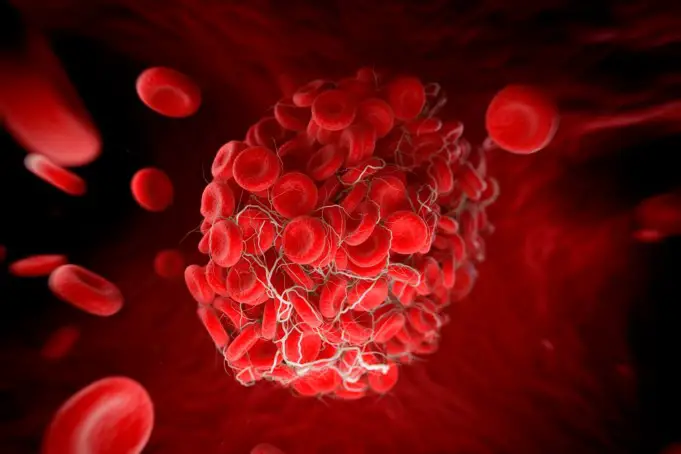Thrombocythemia also known as Essential or Primary Thrombocythemia is a condition in which occurs when the platelets or thrombocytes are higher than normal. This condition can occur due to malfunction in the bone marrow causing it to produce too many platelets.
Since platelets play an important role in blood clotting, by preventing excessive loss of blood when injured, this abnormal condition (thrombocythemia) may be dangerous as it can cause blood to clot for no reason and can lead to blockage of blood flow to vital parts of the body such as the brain, heart, and liver.
Causes of Thrombocythemia
Although the exact cause of this condition may be unknown. However, research shows that it could be traced to gene mutation or reactive thrombocytosis.
Symptoms of Thrombocythemia
This condition does not usually cause symptoms. However the first and most common sign that indicates primary thrombocythemia is blood clot. The blood clot can form anywhere in your body especially in the hands, feet, and brain.
The symptoms of blood clot differ depending on the location of the blood clot. These symptoms include;
- Weakness
- Headache
- Dizziness
- Throbbing, redness, and burning pain in hands and feet
- Fainting
- The spleen becomes enlarged slightly
- Numbness
- Chest pain
- Vision changes
Rare cases of primary thrombocythemia can cause bleeding. Symptoms include;
- Bleeding from nose
- Bleeding from gum
- Bloody stool or urine
Diagnosis of Primary Thrombocythemia
This condition is diagnosed by a doctor. The doctor will perform a physical check or exam and ask questions pertaining to your medical history.
Ensure to mention any medical procedures you might have had in the past, blood transfusions, infections, supplements, and over-the-counter medications you might have been taking.
If the doctor suspects primary thrombocythemia, he will ask you to run certain tests (blood tests) in order to confirm the diagnosis. These blood tests include;
- Blood smear: This test is carried out to examine the condition of the platelets.
- Genetic testing: This test will help to ascertain whether the condition was inherited.
- Complete blood count (CBC): This test is carried out to measure the total numbers of platelets present in your blood.
Another diagnosis may include;
Bone marrow aspiration: This test is carried out to examine the platelets under a microscope.
If the doctor can’t find a cause for your platelets count he will most likely diagnose you of primary thrombocythemia.
Risks and Complications of Primary Thrombocythemia
Primary thrombocythemia is a condition that poses a high risk for women who are pregnant. Women who suffer from this condition and also take pills for birth control have a high risk of blood clots.
Since this condition causes blood to clot anywhere in the body, it can cause blood to clot in the placenta which can lead to fetal development problems or miscarriage.
The blood clot can also cause a stroke or transient ischemic attack which could lead to confusion, blurry vision, seizures, numbness, difficulty in speaking, and shortness of breathe.
People who suffer from primary thrombocythemia are also at a high risk of a heart attack. This is because blood flow to the heart could be blocked by blood clot. Some known symptoms of heart attack include;
- Pain that extends to the arms, back, shoulder, or jaw.
- Clammy skin
- Shortness of breathe
- Squeezing pain in the chest that lasts for more than a few minutes.
Make sure you call a doctor, or go to the hospital if you are experiencing symptoms of blood clot, stroke, heavy bleeding, or heart attack. These conditions are considered as emergencies and immediate treatment is required.
Treatments
The treatment for people who suffer this condition, depends on some factors such as the patient’s risk of developing blood clot.
Some people may not need treatment, especially if they do not have any additional risk factors, or symptoms. However, treatment is requires if the patient is above 60 years, have history of blood clot or bleeding, smoker, or suffer from cardiovascular disease.
Treatments may include;
- Platelet pheresis: This is a procedure that helps to remove platelets from the blood directly.
- Prescription medications: This can help to reduce the production of platelets in the bone marrow and also lower the risk of clotting.
- Over-the-counter low dose: You can take drugs such as aspirin which may reduce or lower blood clotting.
Prevention of Thrombocythemia
There is no known way to prevent this condition, but there are ways for you to reduce the risks of serious complications.
To manage the risk of this condition such as blood clot, you need to control your blood pressure and cholesterol.
You may also need regular exercise and a healthy diet which contains fruits, whole grains, vegetables and lean protein.
It is important to stop smoking. This is because smoking increases risks of blood clot. Other ways to lower the risks of serious complications include;
- Avoid over-the-counter medications that increases the risk of bleeding.
- Avoid sports and activities that increases the risks of bleeding.
- Take all medications as prescribed by the doctor.
Conclusion
Depending of a number of factors, most people with this condition do not experience complications for a long time. However it is important to go to the hospital when serious complications such as heart attack, heavy bleeding, stoke, miscarriage, premature delivery, blood cancer, myelofibrosis and acute leukemia occurs.
References;
- Causes of Primary Thrombocythemia: HealthLine
- Thrombocythemia: Wikipedia













